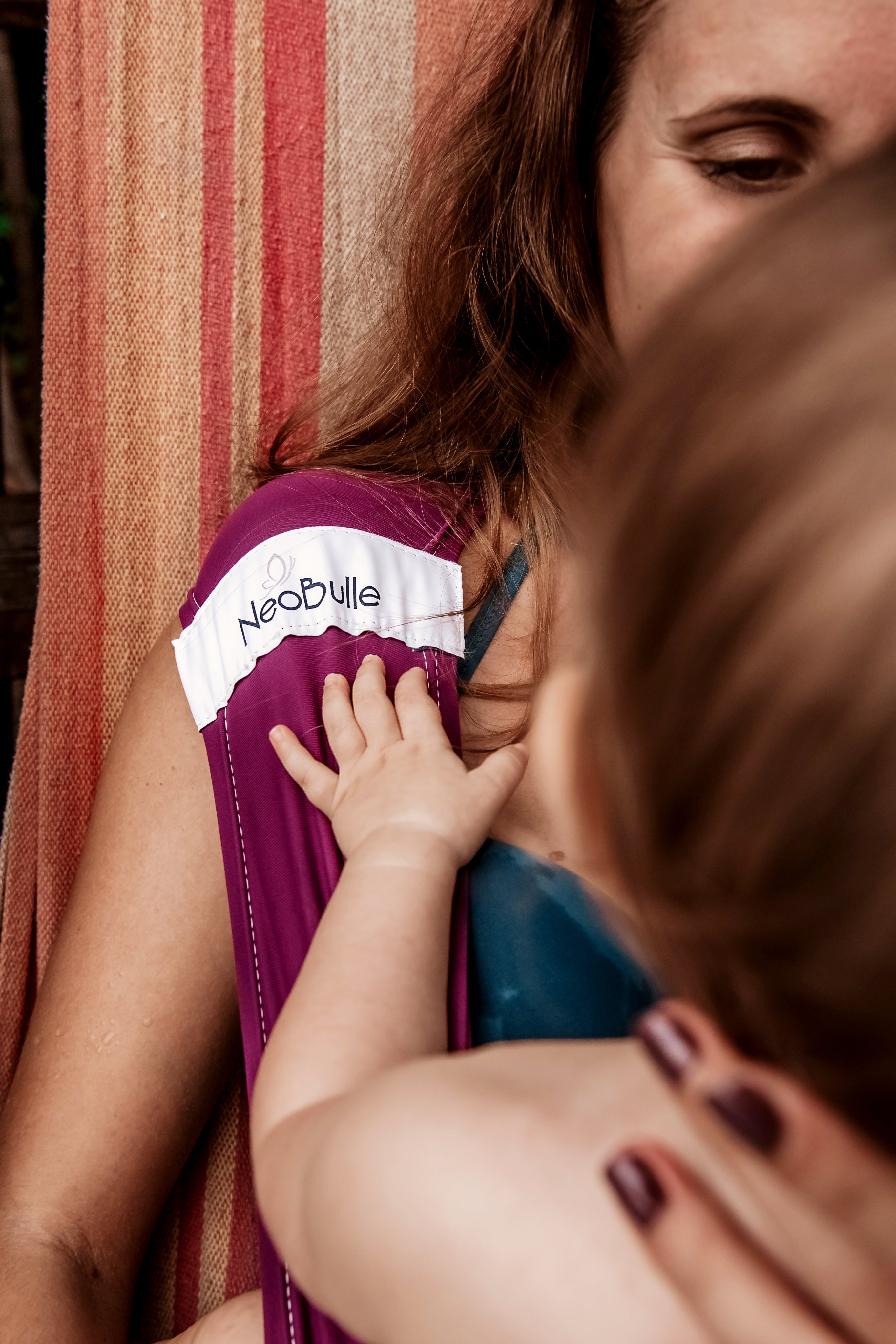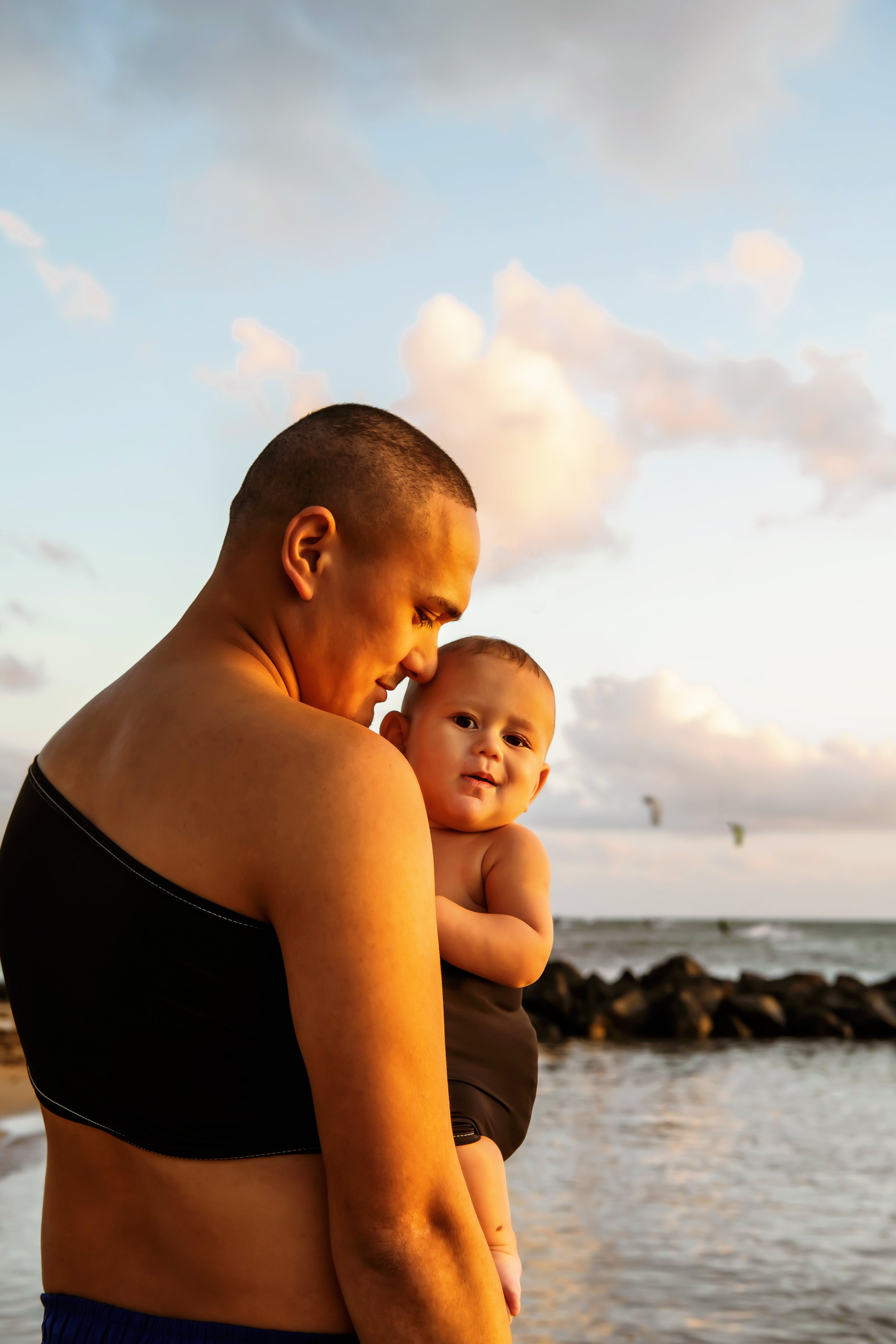Today's article is about the sling, otherwise known as "the scarf with rings" or even more commonly "the thing that's simpler than the scarf but yes, you can see it on the shoulder there." So, who is the sling for, what is it used for, what are the advantages and disadvantages? We'll give you all the details!
What is a sling?
The sling is a carrying system made up of a strip of fabric (the same as our baby slings) approximately 1.90m long by 0.70m wide , at one end of which 2 aluminum rings are sewn.
To use the sling, you must first "assemble" it, as they say in the jargon, by passing the other end of the material through the two rings, then again in the other direction between the two rings (a bit like the double-buckle belts found in some sportswear).

The main features of the sling
The sling is put on a bit like a Miss France (or Mister Universe) sash, slung over the shoulder of the wearer , with the excess material hanging from the rings like a tie .
The baby is placed vertically in the pocket thus created (like in a sling), and the adjustment is easily done with one hand by applying tension around the baby via the tie which comes out of the rings.

Due to its configuration, the sling requires off-center carrying . In fact, on the wearer's torso, two elements must be positioned: the baby and the rings. If the baby is positioned in the center of the torso, there is no more room for the rings and this can lead to problems with the stability of the installation (the material near the rings is quite grouped and cannot encompass the baby's entire seat, stopping instead at mid-thigh instead of the hollow of the knee) and discomfort (it cannot be adjusted correctly because the baby ends up stuck to the rings).
The choice of side depends on our laterality: the rings are most often installed on the predominant side because on the one hand it is the arm which will then be the freest (for eating, for example), and on the other hand we are generally more precise in adjusting with our dominant hand. For 95% of right-handers, the rings will be on the right. The situation for left-handers is more ambiguous and depends on how much we upset them when they were younger!
The sling is a carrying system that has stood the test of time ; it can be used with a newborn as well as an older baby (in addition to a system that distributes the load better). It is particularly ideal when you need to carry a toddler who is tired of walking for a few minutes.
What are the advantages of the sling?
The sling is THE practical system par excellence! It does not drag on the ground during installation, can be easily adjusted and de-adjusted with one hand, can be set up in record speed , and requires very little handling . At the expert level (understand: not in the learning phase!), it is the only carrying system that can be installed directly with a baby in your arms without the need to put them down first (useful when they have FINALLY fallen asleep on you, weigh a dead donkey in your arms, but will wake up instantly as soon as they are in their bed). It also allows you to breastfeed while carrying without difficulty.
This is the system that you put on in 2-2 for all the little daily carrying tasks , to go and get the mail, throw out the garbage, buy bread, do a quick little errand after getting out of the car, or even to take an older child to school or nursery (NB: at the expert level the sling can be perfectly installed while running after the older child who does not want to put their shoes where often for the others, you have to stay stopped while making the adjustments) but also when the baby is grumpy, wants to be held then no longer wants them...
It's both a cocoon for baby and space-saving for the wearer. Taking up little space, it slips easily into the trunk, diaper bag, stroller tray, or around your neck as a scarf.
Its off-center use makes it a great ally in everyday life: when baby is on his stomach, he takes up all your space and hinders your mobility, making it more difficult, for example, to pick up an object from the floor, empty the dishwasher, or just, more prosaically, to eat. Your little one is a little more open to the outside world and will more easily observe his environment, or what you show him. Bonus: the space freed up on your chest also allows older children to come and cuddle without their little brother or sister blocking the way.

The disadvantages of the sling
Since perfection is not of this world, carrying in a sling also has some disadvantages!
Off-center carrying on one shoulder also means that the sling is not intended to be used for long periods of time. It is a model primarily designed for backup ! If you plan to go on long walks while carrying a baby, it is better to plan for another system as a complement, otherwise your back and neck may painfully remind you to be careful.
We could compare baby carriers to pairs of shoes. The baby sling would be the equivalent of a pair of hiking boots, which you take the time to adjust properly and then walk for a long time without pain. The sling is the pair of flip-flops for babywearing , the shoes you put on "on the fly" to go out quickly without hurting your feet but in which you won't cover a long distance.
The subtlety lies in the fact that most of the daily carrying times are ultimately short . No one puts on a scarf for 5 minutes, a sling yes. The estimated 5 minutes often turn into 1 hour (we always get caught!), it is better to have installed your baby in a sling than to keep him in your arms without any other support. The comparison of comfort is thus made not between the scarf and the sling but rather between the sling and the arms . We do at least worse in a way.
Someone whispers in my earpiece that it would be enough to change shoulders each time you carry them to balance them: this would be like saying to write with your left hand to relieve your right wrist when you are right-handed, unless you are perfectly ambidextrous, no one does that (and even then, even ambidextrous people ultimately have a preferred side!). In a very hectic daily life with a toddler, we tend towards the easy option, namely always carrying on the usual side .
Another small warning: its simplicity of use also paradoxically makes it a system that is sometimes complicated to understand. As with all other baby carriers, it is advisable to take the time to understand the mechanism of use and to take the time to learn how to use it .
The main technicality consists of keeping the rings high on the shoulder during installation, the problems of rings "which descend" are often listed in the problems of use. This is entirely linked to the off-center configuration of the carrying: as soon as we start to position the baby in the center at the beginning of installation, this mechanically makes the rings descend when we try to shift the baby a little since we pull the sling with it. To overcome this, simply remember that we cannot work in front , we will make sure to pick up the baby as if we wanted to install him on the hip and move him as far away from the rings as possible when we sit him in the material. The adjustments then bring baby and rings closer together, so you must anticipate by being at the beginning a little further on the hip than what you want at the end. At the end of installation, the rings should be roughly at the height of your child's head .
Don't hesitate to get help from an instructor to learn!
In short, you will have understood, the sling is an everyday essential . If it generally needs to be supplemented by another baby carrier which distributes the load better in case of a walk, it is the hands-free kit par excellence which will delight you with its practicality and its relative simplicity of use.





